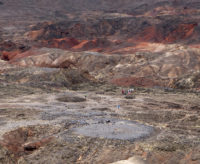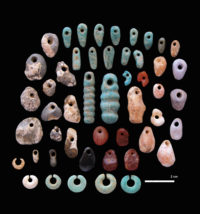 Archaeologists have discovered the largest and earliest cemetery in east Africa built 5,000 years ago by herders around Lake Turkana, Kenya. Researchers from Stony Brook University and the Max Planck Institute for the Science of Human History excavated the site and discovered a dense grouping of interrals in a central cavity with scattered associated burials around it.
Archaeologists have discovered the largest and earliest cemetery in east Africa built 5,000 years ago by herders around Lake Turkana, Kenya. Researchers from Stony Brook University and the Max Planck Institute for the Science of Human History excavated the site and discovered a dense grouping of interrals in a central cavity with scattered associated burials around it.
The Lothagam North Pillar Site, constructed and in active use between 5,000 and 4,300 years ago, consists of a massive platform 100 feet in diameter with a large funerary cavity in which the dead were buried over time. When the cavity was full, burials ceased and it was capped with stones. Megalith pillars were then placed on top of the cap and additional stone circles and cairns were added around the site.
 The central cavity held as estimated 580 individuals, men, women, children, seniors. All of the burials regardless of sex, gender or age included grave goods and none of them were given more or more valuable objects. A wide variety of stones and minerals carved into more than 300 beads of many different forms were unearthed in the graves. Fashioning these handsome ornaments would have taken a lot of time, creativity and dedication, attesting that the people of the Lothagam North Pillar Site placed importance on aesthetics, individual style and adornment.
The central cavity held as estimated 580 individuals, men, women, children, seniors. All of the burials regardless of sex, gender or age included grave goods and none of them were given more or more valuable objects. A wide variety of stones and minerals carved into more than 300 beads of many different forms were unearthed in the graves. Fashioning these handsome ornaments would have taken a lot of time, creativity and dedication, attesting that the people of the Lothagam North Pillar Site placed importance on aesthetics, individual style and adornment.
The grave goods are equally distributed over the burial ground, not concentrated in any area or areas, nor were any individuals interred in a manner meant to single them out for special attention and honor. They were tightly packed in the cavity. This indicates the pastoralists who built and used the monumental cemetery did not have a strong hierarchies in their society.
That is a highly significant find from a social history perspective because it contradicts the widespread notion that the construction of large public monuments and buildings was a function of stratified hierarchical societies, that a concentration of wealth and power and the desire to show them off were requirements for projects of this magnitude in early civilizations. The herders of Lake Turkana had an egalitarian society for hundreds of years.
“This discovery challenges earlier ideas about monumentality,” explains Elizabeth Sawchuk of Stony Brook University and the Max Planck Institute for the Science of Human History. “Absent other evidence, Lothagam North provides an example of monumentality that is not demonstrably linked to the emergence of hierarchy, forcing us to consider other narratives of social change.”
The discovery is consistent with similar examples elsewhere in Africa and on other continents in which large, monumental structures have been built by groups thought to be egalitarian in their social organization. This research has the potential to reshape global perspectives on how—and why—large groups of people come together to form complex societies. In this case, it appears that Lothagam North was built during a period of profound change. Pastoralism had just been introduced to the Turkana Basin and newcomers arriving with sheep, goats, and cattle would have encountered diverse groups of fisher-hunter-gatherers already living around the lake. Additionally, newcomers and locals faced a difficult environmental situation, as annual rainfall decreased during this period and Lake Turkana shrunk by as much as fifty percent. Early herders may have constructed the cemetery as a place for people to come together to form and maintain social networks to cope with major economic and environmental change.
“The monuments may have served as a place for people to congregate, renew social ties, and reinforce community identity,” states Anneke Janzen also of the Max Planck Institute for the Science of Human History. “Information exchange and interaction through shared ritual may have helped mobile herders navigate a rapidly changing physical landscape.” After several centuries, pastoralism became entrenched and lake levels stabilized. It was around this time that the cemetery ceased to be used.
The study has been published in the Proceedings of the National Academy of Sciences.
Nice scoopy, cuppy thing!
I found it interesting that upon close inspection the pendants in the bottom row are actually penannular (“almost a circle”). I had originally thought that the gaps at the top were black cords or thread attaching them to the display board.
This may have had some esthetic or religious significance. Crecents, even exaggerated ones, have been interpreted as having connection with the moon.
Also, cutting a gap like that involves a different technical process than just drilling a hole which would have been done with a bow drill and an abrasive (often quartz sand).
Interesting stuff as always here!:)
I am into geology- so gawked at the ground mineral beads. I was foolishly assuming perhaps the blue ones were a turquoise…
Of course I clicked the pic to enlarge!
Oh surprise!
Blue was surely amazonite (the blue form of microcline feldspar.) I checked and Yes, Kenya IS known for having deposits of such. LoL!
Looks like some amethystine purple, and some red agate/chalcedony, too.
I would comment, on prior comment about ground beads. (btw-I kinda thought at initial glance they were strung with black too! LoL)
At some recent-ish point, there was research done on drilling shell beads(I generalize here-no quote)Midwest USA- aprox 1200ad, and I believe lithics too…
Larry Kinsella of IL… They found the bow drill shafts worked perfect only with powdered chert-quite an angular material at any size, easily sourced from knapping debris! Sand acted like ball bearings, not cutting, but ate up the organic drill shaft!
Granted- sand can be many different qualities, and grits, so I’m just jabbering in ‘peanut gallery’! YMMV?~
Carry on y’all-Best regards~
~JO:)
I first assumed the slots were due to wear, but now I wonder whether the slot is to make it wearable, on a nose or ear, say.
Dear Trevor,
I thought the same thing but I think the slots are too narrow to insert an ear lobe or a nasal septum. Maybe someone with more personal experience with piercing and personal adornment can weigh in on this hypothosis.
Wear, IMO, would leave a broader gap. this looks more intentional. It could possibly be done with a cord and an abrasive.